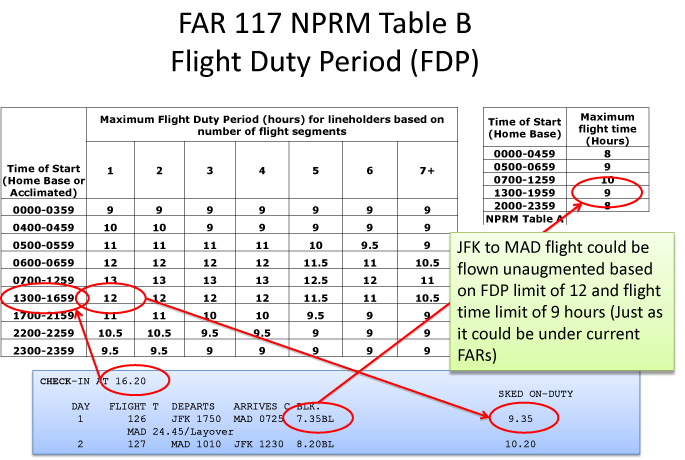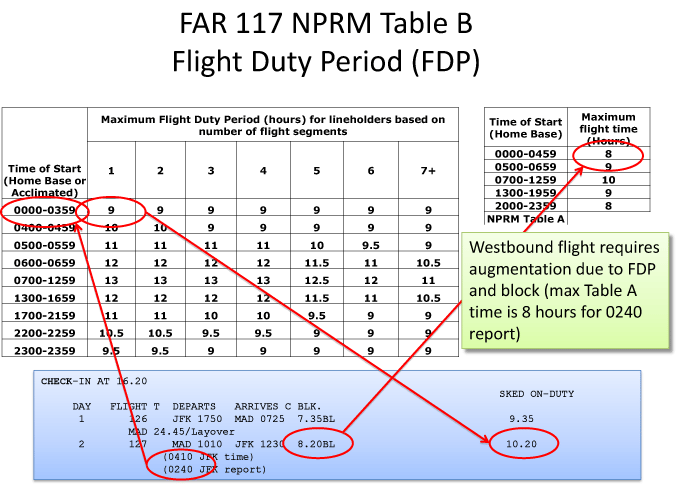|
ALPA is pleased that the FAA has released a Notice of Proposed Rule Making (NPRM)
for amending the current flight, duty, and rest regulations. As we all know, an
overhaul of the flight and duty regulations is overdue.
Although ALPA experts have been reviewing the rule and receiving feedback
from members since the FAA unveiled the NPRM on September 16, the next step in
the process is a thorough review of the proposed rules by the Flight Time/Duty
Time Committee (FTDT) and ALPA representatives to the FAA’s 2009 Aviation
Rulemaking Committee (ARC). The committee will evaluate how its recommendations
during ARC proceedings were captured in regulatory language and compare the NPRM
with current ALPA policy. This step will occur during the first week of October,
and will conclude with ALPA’s written response to the NPRM, which is due
November 15, 2010.
While the analysis of and comment on the NPRM is pending, a few components of
the NPRM deserve an initial explanation to put the entire NPRM in the proper
context. Outlining these components for you today does not imply ALPA’s
agreement or disagreement with the NPRM in any way. That process will be
completed soon and will be guided by ALPA policy. This is provided to give you a
glimpse of how some elements of the NPRM are interwoven.
In this FastRead, we will look at
- the proposed § 117.15 Table Flight Duty Period: Un-augmented Operations,
specifically the application of the table;
- the proposed § 117.13 Flight time limitation and how it differs from the
current FAR;
- the proposed § 117.25 Rest period and how it differs from the current
FAR; and
- the relationship of the proposed FAR and current collective bargaining
agreements.
The proposed § 117.15 Table Flight Duty Period: Un-augmented Operations
(Table B)
Let us start with the table itself and how it differs from the current FAR.
| Proposed FAR Part
117 |
|
| Time of Start (Home
Base or Acclimated) |
Maximum Flight Duty
Period (hours) for lineholders based on number of flight segments |
Current FARs
regardless of planned flight segments |
Reduction in duty day
from current FAR (single segment) |
Percent reduction in
allowable flight duty period (single segment) |
| |
1 |
2 |
3 |
4 |
5 |
6 |
7+ |
|
|
|
| 0000-0359 |
9 |
9 |
9 |
9 |
9 |
9 |
9 |
16 |
7 |
43.75% |
| 0400-0459 |
10 |
10 |
9 |
9 |
9 |
9 |
9 |
16 |
6 |
37.50% |
| 0500-0559 |
11 |
11 |
11 |
11 |
10 |
9.5 |
9 |
16 |
5 |
31.25% |
| 0600-0659 |
12 |
12 |
12 |
12 |
11.5 |
11 |
10.5 |
16 |
4 |
25% |
| 0700-1259 |
13 |
13 |
13 |
13 |
12.5 |
12 |
11 |
16 |
3 |
18.75% |
| 1300-1659 |
12 |
12 |
12 |
12 |
11.5 |
11 |
10.5 |
16 |
4 |
25% |
| 1700-2159 |
11 |
11 |
10 |
10 |
9.5 |
9 |
9 |
16 |
5 |
31.25% |
| 2200-2259 |
10.5 |
10.5 |
9.5 |
9.5 |
9 |
9 |
9 |
16 |
5.5 |
34.38% |
| 2300-2359 |
9.5 |
9.5 |
9 |
9 |
9 |
9 |
9 |
16 |
6.5 |
40.63% |
One of the most misunderstood aspects when using Table B is where to enter
the table itself. It is important to enter the Time of Start column using your
home base (domicile) time unless you are acclimated to another time zone. For
the vast majority of cases, your home base time zone will be used. Most errors
in the application of the table occur when you are applying the table after an
international flight segment and beginning a new FDP.
Let’s look at a practical application. The first example is a flight flown
from JFK to Madrid. Using the trip description, you can see that the report time
is 1620. That time should be used to determine the allowable FDP and flight
time:

Key points:
- Remember to enter the table with your report time, not your departure
time.
- Both the FDP and flight time limit control. If either is exceeded,
augmentation is required.
Now, let’s look at the return flight. In this case the report time is 0240
JFK time, based on a 90-minute report before a 0410 departure, also converted to
JFK time (90 minutes report in this example is contractual for this carrier):

Key points:
- Ensure that you enter the table with the report time, based on home base
time (domicile), both for FDP and allowable flight time limitations.
- In this example, entering with MAD time instead of JFK time would result
in an allowable FDP of 12 and allowable flight time of 9 not requiring
augmentation, and would be an incorrect use of the FDP and
Flight Time Tables (Tables A and B).
How the proposed § 117.13 Flight time limitation table differs from the
current FAR § 117.13 Flight time limitation
No certificate holder may schedule and no flightcrew member may accept an
assignment or continue an assigned flight duty period if the total flight time:
(a) Will exceed the limits specified in Table A of this part if the
operation is conducted with the minimum required flightcrew.
Besides the actual changes in the allowable flight time per flight duty
period, the proposed FAR is no longer just a scheduling rule, but also an actual
flight time per duty period rule.
The proposed § 117.25 Rest period and how it differs from the current FAR
§ 117.25 (d) No certificate holder may schedule and no flightcrew member
may accept an assignment for reserve or a flight duty period unless the
flightcrew member is given a rest period of at least 9 consecutive hours before
beginning the reserve or flight duty period measured from the time the
flightcrew member reaches the hotel or other suitable accommodation.
The most significant change in the proposed FAR concerning rest is that it is
measured from the time you reach the place of rest. Effectively, it appears the
FAA will no longer deal with the concept of “transportation local in nature.”
Today, as we know, the rest period is measured from release from duty to report
for duty and includes travel time to a local hotel. The basis of the ARC
participants’ minimum rest period recommendation was to allow for an eight-hour
sleep opportunity, and the committee will analyze the FAA’s proposed rule
against that and ALPA policy.
The relationship of the proposed FAR and current collective bargaining
agreements
One question we have been asked is how any FAR change would interact with a
collective bargaining agreement section. The bottom line is this—upon
implementation, if the FAR is more restrictive, it will control. If the
contractual provision is more restrictive, it will control, just as it does
today. As you can imagine, there could be the need for some negotiations on work
rule and/or scheduling rule provisions at many airlines.
The next steps
As mentioned above, the FTDT Committee and ALPA ARC participants will submit
our comments to the FAA by the November 15th deadline. The basis for comment
will be ALPA policy. Once again, outlining these components for you today
does not imply ALPA’s agreement or disagreement with the NPRM in any way. As
we learn more about the NPRM, we will update you on that information as well as
the final comment to the FAA. |

